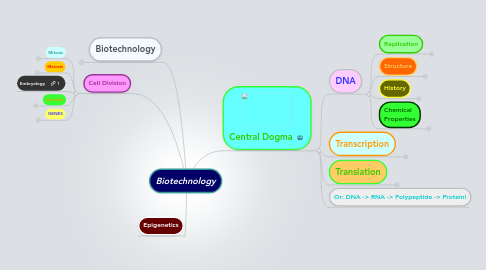
1. Epigenetics
2. Biotechnology
2.1. Evolution
2.1.1. Life
2.1.1.1. Passing of DNA from one organism to the next
2.1.1.1.1. As species evolve, DNA becomes less and less similar
2.1.2. new alleles = COMPETITION
2.2. Sex
2.2.1. DNA is the info. passed on between parents and offspring (chromosomes)
2.2.1.1. Gametes (1/2 genetic data each)
2.2.1.1.1. Sperm
2.2.1.1.2. Egg
2.3. Application
2.3.1. Biotechnology
2.3.1.1. Genetic Modification
2.3.1.1.1. Hybridization
2.3.1.1.2. Animals
2.3.1.1.3. Crops
2.3.1.2. Gene Therapy
2.3.1.2.1. Designer Babies
2.3.1.2.2. Get rid of diseases
2.3.1.3. Agriculture
2.3.1.4. Cloning!
2.3.2. DNA testing
2.3.2.1. Electrophoresis
2.3.2.2. Parent Match
2.3.2.3. Homicide Investigations
2.3.3. Research (origins)
3. Cell Division
3.1. Mitosis
3.1.1. make an exact copy of the cell: SOMATIC CELLS: 2n cells
3.1.1.1. CELL CYCLE
3.1.1.1.1. Interphase
3.1.1.1.2. Mitosis
3.1.1.1.3. Problems
3.1.1.1.4. Apoptosis
3.2. Meiosis
3.2.1. synthesize GAMETES: 1n cells
3.2.1.1. Eggs, sperm
3.2.1.1.1. 1 cell becomes 4 gametes
3.3. Embryology
3.4. Heredity
3.4.1. What is heredity?: The passing of traits from parents to offspring.
3.4.1.1. Sexual Reproduction: 2 parents. Each contributes roughly 1/2 genetic data for the offspring. MIXING of traits.
3.4.1.1.1. Today, heredity can help explain family traits, diseases, and other important topics. Let's focus on the genetics behind Heredity in "GENES"
3.4.1.2. Asexual Reproduction: exact copy, identical traits
3.5. GENES
3.5.1. individual portions of the DNA that code for protein products; in this case, for heredity!!
3.5.1.1. Alleles
3.5.1.1.1. Sometimes, DNA mutates. In some cases, this mutation can create a new form of a gene.
3.5.1.2. Gene Locus
3.5.1.2.1. The base pairs of the gene in relation to the chromosome
3.5.1.3. Genotype
3.5.1.3.1. The genetic code within each sex cell/zygote. What the DNA codes for.
3.5.1.4. Phenotype
3.5.1.4.1. The resulting protein/trait from the DNA
3.5.1.5. Chromosome
3.5.1.5.1. A collection of genes (DNA) wrapped around histones (chromatin). Humans have 23
4. Central Dogma
4.1. DNA
4.1.1. Replication
4.1.1.1. Semiconservative
4.1.1.2. Builds 5' --> 3'
4.1.1.2.1. Leading Strand = continuous build
4.1.1.2.2. Lagging strand = short portions
4.1.1.2.3. shortens every time (remove primase from 5' end)
4.1.1.3. Helicase (unwinder)
4.1.1.3.1. Single Stranded Binding Protein (SSB)
4.1.1.4. BIG PICTURE
4.1.1.5. CANCER
4.1.1.5.1. mutation in DNA
4.1.1.5.2. what causes it? MUTAGENS
4.1.2. Structure
4.1.2.1. Double helix
4.1.2.1.1. 2 anti-parallel strands
4.1.2.2. Phosphate -> Sugar backbone
4.1.2.2.1. 5' --> 3' !
4.1.2.3. hydrogen bonds between nucleotide bases (A to T; G to C!)
4.1.2.4. Methylated (locked) and wrapped around histones to form chromatin (folded into chromosomes)
4.1.2.4.1. how we pass on our genes!
4.1.2.5. hydrogen bonds between nucleotide bases (A to T; G to C!)
4.1.2.6. Methylated (locked) and wrapped around histones to form chromatin (folded into chromosomes)
4.1.2.6.1. in the cell nucleus
4.1.3. History
4.1.3.1. Griffith's Transforming agent
4.1.3.1.1. Chagraff's rules: concentrations of the complementary bases are equal in humans- %A=%T and %G=%C
4.1.3.2. Watson and Crick discover double helix
4.1.3.3. Rosalynd Franklin's X-ray crystallography helped! Showed pitch (bases/rotation) and bend (horizontal length of each turn)
4.1.3.4. DEBATE! DNA or PROTEINS = genetic material? Why? Proteins have 20 amino acids, DNA has only 4 nucleotide bases.
4.1.3.4.1. Hershey-Chase Experiment
4.1.3.5. Avery, MacLeod, and McCarthy prove this by confirming Griffith's "factor" via experiments
4.1.3.5.1. Avery Macleod McCarthy experiment
4.1.4. Chemical Properties
4.1.4.1. Built up of nucleotide monomoers
4.1.4.1.1. Deoxyribose (sugar)
4.1.4.1.2. Nucleic acid
4.1.4.1.3. Phosphate group (PO4)
4.1.4.2. Net negative charge
4.2. Transcription
4.2.1. Process
4.2.1.1. INITIATION
4.2.1.1.1. Transcription factors (proteins) are released and bind to DNA at TATA box
4.2.1.2. ELONGATION
4.2.1.2.1. Reads the DNA 3'-->5' and attaches RNA bases one by one 5'-->3', JUST LIKE DNA POLY.!
4.2.1.3. TERMINATION
4.2.1.3.1. Synthesizes RNA! RNA poly. breaks off and 2nd step in Central Dogma complete.
4.2.2. RNA: ribonucleic acid. (DNA + extra OH), 3 types of polymer!
4.2.2.1. mRNA
4.2.2.1.1. AKA messanger RNA
4.2.2.2. tRNA
4.2.2.2.1. AKA transcription RNA
4.2.2.3. rRNA
4.2.2.3.1. AKA ribosomal RNA
4.3. Translation
4.3.1. Process
4.3.1.1. INITIATION
4.3.1.1.1. mRNA, ribosomal subunits, and tRNA all exit the nucleus
4.3.1.2. ELONGATION
4.3.1.2.1. "AUG" codon mRNA attached at the P-site
4.3.1.3. TERMINATION
4.3.1.3.1. The last codon attracts the RELEASE FACTOR (special protein)
4.3.2. the RIBOSOME
4.3.2.1. protein synthesis machine
4.3.2.1.1. built of rRNA and proteins
4.3.2.1.2. Small subunit
4.3.3. Proteins!
4.3.3.1. peptide chain is ALMOST a protein!
4.3.3.1.1. combines with additional peptide units (quaternary structure)
4.3.3.1.2. enters CHAPERONIN (safety basket)
4.3.4. Eukaryotes
4.3.4.1. Intracellular protein synthesis
4.3.4.1.1. nucleus
4.3.4.2. Intercellular protein synthesis
4.3.4.2.1. nucleus
4.3.5. Prokaryotes
4.3.5.1. have it made!
4.3.5.1.1. no editing
